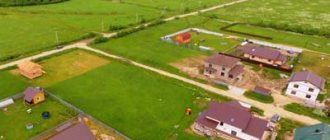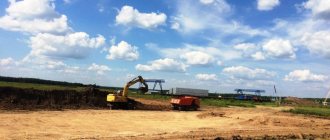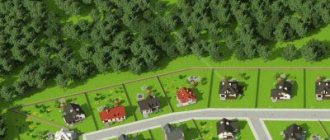The lands of the Russian Federation are divided according to the VRI classifier (types of permitted use).
In large cities, individual housing construction (IHC) is mainly used for private construction.
With this type of use, you can build residential buildings and utility rooms , and grow garden and vegetable crops on the site.
In rural areas, as well as in urban settlements, for private construction, private subsidiary plots (LPH) are mainly provided for. In addition to the above, you can engage in cattle breeding and raising .
Personal subsidiary farming - what does it mean?
What is a plot for private household plots, what is it and how can it be used? Personal subsidiary farming is a type of permitted land use. You can see the full VRI classifier in another article.
According to current legislation, this term refers to a plot of land used for farming for its own (non-industrial) purposes.
One specific person alone or together with his family (relatives) has the right to engage in farming without restrictions.
By housekeeping we mean:
- growing agricultural products;
- its processing;
- livestock breeding;
- breeding poultry.
Non-industrial use, does not prohibit the owner of the site from selling surplus products .
In addition to the type of permitted use, there is an even broader concept - the category of land.
The legislation of the Russian Federation provides for 7 such categories, of which only two attract our attention:
- Lands of populated areas (LNP).
- Agricultural land (ZSN).
Private household plots may be part of one of these categories , and their intended purpose will differ significantly from each other.
Private household plots that are part of the ZNP are called household plots, and those that are part of agricultural land are called field plots.
How can you use your garden plot?
VRI homestead farming is most common in rural areas and urban settlements. It is also found on the outskirts of large cities.
The Land Code of the Russian Federation determined that ZNP should be used for the development and improvement of populated areas.
In accordance with this, on a personal private plot, the owner has the right :
- erect residential buildings and utility rooms:
- grow garden crops;
- garden crops;
- floriculture;
- raise livestock and domestic animals.
For detailed information, read the article about private household plots.
What can you do on the field
In turn, the field plot of private household plots can only be located outside the border of a populated area .
As an example, land plots allocated to villagers for planting potatoes, grain and other crops.
Federal Law No. 112 determined that the field plot of a personal subsidiary plot is intended exclusively for agricultural needs .
Here you can do everything that you can do on a private plot of land, in addition to erecting any buildings.
For detailed information, read the article on field private plots.
Standards for the location of buildings on the land of private household plots
Any building on the lands of private household plots must be located taking into account construction, sanitary and fire safety standards:
- There should be at least 5 m from the building to the road, and 3 m to the driveway.
- The wall of the house must be removed from the border of the site or fence at a distance of at least 1 m.
- The distance between brick or stone structures must be at least 6 m, and between a stone (brick) and wooden structure - at least 10 m. Wooden buildings must be separated from each other at a distance of at least 16 m.
- The distance from a residential building to a toilet, premises for animals and birds, and sedimentation tanks must be at least 12 m.
- There should be a distance of at least 8 m to buildings and bathhouses, wells, and septic tanks.
When measuring distances, the most protruding elements and extensions are taken into account. When planning, buildings are taken into account not only on your own site, but also on the neighboring site.
Development must be carried out taking into account the official “red lines”, i.e. boundaries between plots and common areas.
What is allowed to build
On a personal plot of land it is allowed to build:
- residential buildings intended for single-family residence with no more than three floors, excluding basements;
- utility rooms such as garage, shed, storage room;
- other structures for personal use: bathhouse; summer kitchen, etc.
All objects must not violate the norms and rules of local urban planning regulations, and must also be agreed with the local administration . But there is a caveat here: in addition to the main type of permitted use, any land plot may also have an auxiliary VRI.
An auxiliary VRI is always used in conjunction with the main one and there is no need to obtain a separate permit for the construction of buildings of this type.
On a site with the main type of use being personal private plots, auxiliary VRI will be the construction of buildings for household and utility purposes, which means:
- barn,
- garage,
- pigsty,
- chicken coop, etc.
If necessary, build other structures on the site that represent
- shop,
- hairdresser
- or dining room,
it is necessary to obtain appropriate permission from the land use commission, which can allocate the site with a conditionally permitted VRI.
How to determine the category and type of permitted use
The category of land and the type of permitted use of the land can be viewed in the cadastral passport of the site.
In the document, paragraph 8.1 lists all possible categories of land; in paragraph 8.2, there is a corresponding mark opposite the desired category.
If the site is included in the ZNP, then under it there will be the inscription “All”.
Clause 9 informs about the type of permitted use.
If this is a private plot, it will be indicated: “For agricultural purposes” or “For running a personal subsidiary plot.”
If you do not have a cadastral passport on hand, the owner of the plot can submit a request for its registration.
Otherwise, you can find out the VRI of the site in the following ways:
- View the rules of land use and development of your locality, where not only the existing VRI of the site will be indicated, but also all conditionally permitted types of use possible for assignment.
- Make a request to the local administration to provide information about the VRI of a particular site. Only the owner of the plot can make such a request.
A site may have several options for choosing the main type of permitted use. The owner has the right to make a choice in favor of any of them , but one plot can have only one main VRI.
Read more in the articles:
- “How to determine the VRI of a site”,
- “How to find out the category of a land plot by cadastral number or map,”
- “How to find out the category of land for your site: all options.”
On state support for private household plot farmers
Having provided information on how to open private household plots and what taxes are expected of individuals in this field, the regulatory document in Article 7 explains in what areas state support for private household plots is provided.
These measures include:
- Creation of marketing, service and processing cooperatives for simplified marketing of products by farmers.
- Providing agricultural regions with access roads, energy supplies, communications, etc.
- Creation of conditions for free veterinary care.
- Providing financial and material resources on a repayable basis.
All activities are carried out within the framework of relevant programs to support agricultural producers.
Difference from individual housing construction
Here is a comparative table for plots of land for private housing construction and private household plots.
| Index | individual housing construction | Private household plots |
| What can be built | Single-family houses with a total number of floors of no more than three, excluding the basement and utility rooms | Single-family houses with a total number of floors of no more than three, excluding the basement, utility rooms and premises for household needs |
| Project documentation | A project drawn up by an official organization and certified by the local administration is required | All you need is a rough plan for the future construction |
| Construction period | Construction must begin within three years from the date of receipt of the site | There is no time limit for the start of construction |
| What can you do on the site, besides erecting buildings? | Grow garden and vegetable crops, engage in floriculture | Grow garden and vegetable crops, engage in floriculture, raise livestock and poultry, keep bees and more |
| Main location | In cities closer to the central part | In villages, towns, on the outskirts of cities |
Separately, we note that the administration of the locality is trying to prepare in advance all the necessary communications for the individual housing construction zone .
There will certainly be
- city sewerage,
- telephone communication was carried out,
- asphalt has been laid, etc.
In the private household plot zone, the above benefits are also possible, but they are not at all mandatory.
At the moment, there is a process of discussing the issue of liquidating the VRI personal plot of personal subsidiary plot, and giving it the status of individual housing construction.
For detailed information, read the article on comparing private household plots and individual housing construction.
Land for private houses: concept and key features
Individual housing construction plots are plots intended for the construction of low-rise housing. On such a plot you can build:
- cottage;
- barn and other necessary structures.
We have already said that there is a limitation regarding the number of floors of the cottage. In addition, the owner must comply with:
- area of the house (it is limited by town planning standards);
- requirements for the distance between buildings, fences, neighboring plots and the street;
- a ban on the use of buildings located on the site as commercial facilities.
Only one family should live in the house. Before starting construction, site owners order the development of design documentation. It must be agreed in accordance with legal requirements. The conditions apply to the placement of the house on the site. It must be built in such a way as not to disturb neighbors (restrictions apply to the distance to the neighbor's property and the street). A building permit will be refused if the applicant does not have the opportunity to provide communications to the cottage.
After receiving a building permit, the house must be built within 3 years. This condition is also provided by law.
Individual housing construction: about the existing advantages and disadvantages
On land for the construction of private housing, you can build a cottage for year-round living, and register a family in it. Such an allotment is always located within the boundaries of populated areas and gardening associations.
Before investing in a plot of individual housing construction, you need to carefully study all the positive and negative aspects of such an acquisition.
The advantages of such land include the opportunity to:
- year-round residence;
- obtaining official registration;
- use of the services of medical institutions, kindergartens and schools located in the region.
You can purchase a plot for individual housing construction on credit. Many banks offer favorable mortgage programs.
In addition to the advantages, individual housing construction plots also have their disadvantages. These include:
- Cost of land. The price of a plot for individual construction is significantly higher than other land on which housing can also be built.
- Having purchased a plot on which there are no buildings, the owner will have to obtain permission to erect them. The procedure will require additional financial costs.
Before concluding a purchase and sale agreement, real estate experts recommend that you familiarize yourself with the General Plan for the development of the territory. If the construction of multi-storey buildings or roads is planned in the immediate vicinity of the site, it is difficult to call such a neighborhood pleasant. You also need to check if there are medical and child care facilities nearby. If the cottage is used for year-round living, it will be difficult for residents of the area to live without medical institutions and schools.
Privileges
If hired workers were not involved in labor on the site and if its total area does not exceed 50 acres, the products sold (provided they are grown or manufactured within the site) are not subject to tax .
The state encourages citizens and owners to run their own subsidiary plots, and therefore provides owners of field and household plots of private household plots with certain financial subsidies and benefits.
Thus, the local administration is obliged to provide citizens with subsidies , if necessary:
- purchase feed for livestock;
- purchase new agricultural machinery;
- compensate for the costs of slaughtering livestock;
- purchase fuel for agricultural machinery;
- purchase fertilizers;
- purchase veterinary drugs.
The amount of subsidies is set by each region separately.











